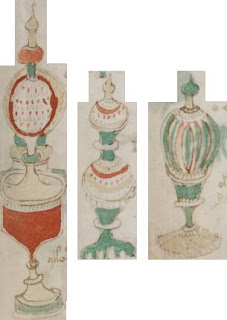The best academic stories normally begin something like “I was chatting with [name-drop] in the bar/taxi/plane/train after the conference when…“: so I’ll do my best to shoehorn the following into that template…
After Day One of the Warwick/Warburg “Resources and Techniques” seminars in Warwick, I ended up standing in the aisle of a packed Virgin Pendolino train all the way to London, in the company of two fellow course participants (Zoe Willis and Charlotte Bolland) and Francois Quiviger, one of the course lecturers from the Warburg Institute. Francois knew little about the Voynich Manuscript, but was interested enough to take a look at the pictures in Jean-Claude Gawsewitch’s “Le Code Voynich“, the (how can I put it any other way?) French coffee-table edition of the VMs. (And yes, I was carrying a copy in my bag: as with all things Voynichian, you make your own luck.)
Francois very kindly suggested a number of things I might consider: for example, when looking at the pharma section, he immediately asked if the idea that the ornate “jars” might be optical instruments (such as unknown kinds of telescopes) had been considered (it has, of course). He also wondered about the apparent resemblance between some of the (apparently) fantastical glass objects in the VMs’ pharmacological section and the monstrance, a word so beautifully obscure I simply had to look up on my return…
 From the dawn of Christianity onwards, many churches owned (or claimed to own) holy relics: bones or teeth of saints, ephemera linked with miracles, nails or fragments from the One True Cross, Christ’s baby teeth, even the Holy Foreskin (yes, really: there’s a fascinating 2006 article from Slate here about its modern history), and so on. (Coincidentally, Michael Cordy’s novel “The Messiah Code” which I mentioned here name-checks many of these still-existent objects of veneration.)
From the dawn of Christianity onwards, many churches owned (or claimed to own) holy relics: bones or teeth of saints, ephemera linked with miracles, nails or fragments from the One True Cross, Christ’s baby teeth, even the Holy Foreskin (yes, really: there’s a fascinating 2006 article from Slate here about its modern history), and so on. (Coincidentally, Michael Cordy’s novel “The Messiah Code” which I mentioned here name-checks many of these still-existent objects of veneration.)
Quite reasonably, many historians now wonder whether many of these were simply medieval money-making scams for attracting pilgrims and parting them from their money: Internet hype, circa 1250. But the pilgrim had to be able to see the relics whose claimed powers they had travelled so far to have contact with (in some cases literally – the blind could allegedly be cured by rubbing the Holy Foreskin on their eyelids, it says here): and therein lay the problem.
Right from the start, boxes or caskets containing relics needed to both protect the relic and to help make it accessible to pilgrims, as well as allowing the relic to be carried around on particular saint’s days: and so these reliquaries evolved into gaudy carrying-cases, sometimes fashioned in part from transparent rock crystal, thus solving all the problems. Technically, the precise term for a partly-transparent reliquary is a a philatory, but this is such an incredibly rare term that it is unlikely to help you much in your Googling: indeed, philatory will get you nowhere.
A monstrance, then, is a very specific kind of philatory, not for an ancient relic but for a special kind of relic that is recreated all the time – the consecrated Eucharistic Host. In Catholicism, the wafer and wine are believed quite literally to turn into Christ’s Body and Blood (the whole process is “transsubstantiation”), a real mini-miracle. Churches needed some affordable way of displaying the Host, of demonstrating the Real Presence of Christ to the assembled faithful: but how?
To solve this problem, someone invented circa 1475 the “monstrance”: a portable golden object, typically with a central “luna”, a circular glass area (for the transformed wafer to slip into for display) not unlike a pair of oversized glass specimen slides (modern monstrances are sometimes categorized by the diameter of the luna). And these remain in use today, with only cosmetic changes from this basic design.
Etymologically, monstrance comes from the same Latin roots from which we get “demonstrate”, and so retains its meaning of ‘showing something’: another obscure word (though one probably even less useful for Scrabble players) for the same object is ostensorium, which is presumably somehow linked with ostentatious.
What I find interesting in all this is that, just beneath the surface history, I can catch a glimpse of the kind of properly Warburgian history Francois Quiviger was talking about when he looked at the pharma section. From 1450 onwards, the invention and manufacture of beautifully-clear cristallo glass in Murano transformed the whole way objects such as philatories and monstrances were conceived: by breaking the need for (what was ludicrously expensive) rock crystal, cristallo made visibility an affordable design feature.
Could it be, then, that what we are seeing in this part of the VMs is not a set of purely fantasy glass objects, but possibly a kind of mangled brochure for a range of designs for cristallo-based philatories or monstrances, in the period at the end of the Quattrocento when the former was somehow seguing into the latter? 1475 is the earliest date I’ve seen quoted for a monstrance, but I would be unsurprised if the actual date of origination were to be found to be a little closer to 1450.
I couldn’t claim (by any stretch of the imagination) to be an expert on early modern reliquaries, philatories and monstrances (and how many such experts are there in the world, anyway?): but it’s an intriguing suggestion, one on which I’d be interested to hear any comments…